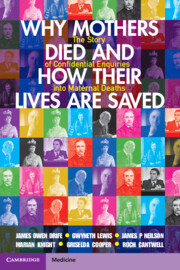 Why Mothers Died and How their Lives are Saved
Why Mothers Died and How their Lives are Saved Published online by Cambridge University Press: 05 April 2023
Haemorrhage is the leading global cause of maternal death. In the 1930s transfusion services were established in British cities, followed in 1946 by a national blood transfusion service. Drugs to cause uterine contraction were developed: ergometrine in the 1930s and oxytocin in the 1950s. In the 1930s obstetric flying squads were established, first in Bellshill and Newcastle, and in Birmingham by Hilda Lloyd, the first female RCOG president. They saved many lives but disappeared as home births fell. In the 1950s iron supplements were introduced into antenatal care to combat pre-existing anaemia. CEMD Reports highlighted the risk of vaginal examination in pregnancy. In the 1970s placental localisation by ultrasound became available. The Reports pointed out that intractable bleeding may need hysterectomy and the 1979-81 Report included the first guideline on emergency treatment of haemorrhage. Guidelines remain essential today, for example in planning care for women who refuse blood transfusion. Ectopic pregnancy can cause catastrophic bleeding in early pregnancy. The Reports showed that ethnic minorities are at higher risk and immediate surgery can be life-saving.
To save this book to your Kindle, first ensure [email protected] is added to your Approved Personal Document E-mail List under your Personal Document Settings on the Manage Your Content and Devices page of your Amazon account. Then enter the ‘name’ part of your Kindle email address below. Find out more about saving to your Kindle.
Note you can select to save to either the @free.kindle.com or @kindle.com variations. ‘@free.kindle.com’ emails are free but can only be saved to your device when it is connected to wi-fi. ‘@kindle.com’ emails can be delivered even when you are not connected to wi-fi, but note that service fees apply.
Find out more about the Kindle Personal Document Service.
To save content items to your account, please confirm that you agree to abide by our usage policies. If this is the first time you use this feature, you will be asked to authorise Cambridge Core to connect with your account. Find out more about saving content to Dropbox.
To save content items to your account, please confirm that you agree to abide by our usage policies. If this is the first time you use this feature, you will be asked to authorise Cambridge Core to connect with your account. Find out more about saving content to Google Drive.